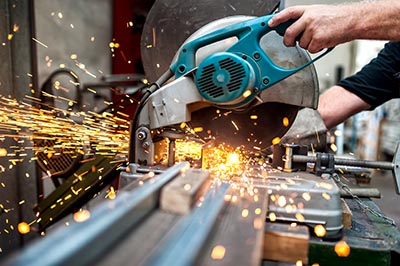
Metal stamping is a process that takes flat sheets of steel and uses tooling to convert the sheet of steel into specifically shaped parts. Metal stamping is a complex process and uses various metal forming techniques such as bending, piercing, blanking, and punching.
Why use the metal stamping process?
There are many positive reasons to use metal stamping over other forms of metal fabrication.
Quality and durability
Metal stamping can reliably produce large quantities of parts at a high standard as well as giving users the ability to create highly durable parts quickly by adding bends and other features during the design phase to add rigidity.
Low cost
After the initial setup phases, such as design and prototyping, the parts can be produced en-masse very quickly and for a low cost when compared to other metal fabrication processes that may require multiple workers and machines.
Fast turnaround times
Due to the sheet being stamped quickly and in most cases by automation, the turnaround time of the part is very quick, allowing large quantities to be made and then moved either to the next in-house step of the production phase or directly to the customer in a timely manner.
The basic stamping process
Design
Before any part is stamped the tooling for the part must be created virtually using CAD/CAM engineering and design software based on the company’s or customers’ needs and input.
The designs of the tooling need to be very precise and ensure that the punches, flanges, and bends maintain a high tolerance dimensionally and have the proper clearance and the highest part quality possible.
CNC machining
After designing the tooling, it will then be created by using CNC machining such as a mill.
Mills such as 3-axis or 5-axis mills have a high level of precision, and when creating the tooling for metal stamping, can keep tolerances within 1/1000th of an inch even when milling hardened tooling steel.
Wire EDM
Wire EDM or (electrical discharge machining) can be used in place or in conjunction with CNC machining to help create the tooling as well. Wire EDM technology uses copper wire, electricity, and de-ionized water to cut through metal at a microscopic level by cutting away the metal microns at a time with a wire that’s no wider than a human hair.
In the right hands, Wire EDM can hold incredibly tight tolerances and is preferred in specific tool-creating situations.
Secondary processes
Heat treating is applied after machining to harden the steel. This hardening allows the tooling to withstand the forces, pressure, and repetitive use, allowing it to last considerably longer when compared to mild steel.
After heat treating, grinding of surfaces might be done if the finished part needs to maintain high surface quality and dimensional accuracy.
Metal stamping techniques
There are multiple techniques or processes that can be used when it comes to stamping a part. These processes can vary depending on the complexity of the part or for design considerations.
Four-slide stamping
In four-slide stamping, the stamping machine uses four tools simultaneously to shape a part. Four-slide stamping has several advantages that make it the preferred choice when creating parts; these advantages are flexibility for future design changes and versatility in the creation of complex parts. Each of the four slides has a different tool attached, allowing for the capability to achieve four bends simultaneously and in quick succession.
Progressive die stamping
Progressive die stamping features multiple stations, each performing a single or unique function in the overall part creation process.
Metal sheets are run off of a coil and are fed into the progressive die stamping press. When feeding through the die stamping press, each station performs a different function such as a punch, bend, or cut.
Each station or step in the process adds to the step before it, with the end result being the finished product.
Due to this staged process which requires multiple steps, some manufacturers may have to repeatedly change the tooling during the process and/or operate multiple presses simultaneously for one part.
In most cases, with progressive stamping, the manufacturer may need to do further machining of the part to get it to full completion.
Progressive stamping is a great stamping process to use for overly complex parts in order to meet fast turnaround times and lowered labor costs. Progressive stamping is also great for mass production parts due to its benefits of having high repeatability.
Deep draw stamping
Deep-draw stamping is the type of stamping that comes to mind when the general public thinks of metal stamping. Some examples of products produced by deep draw stamping would be aluminum beverage cans, kitchenware like pots and pans as well as other utensils.
Deep-draw stamping is also used throughout the automotive and aerospace industries as well, with parts like car doors and fenders being a prime example of deep draw stamping.
With deep draw stamping, the steel sheet is pulled into the die and punched to create the desired shape. From there, it gets stamped into the tooling to create the part.
Transfer die stamping
Transfer die stamping is very similar to progressive die stamping. The difference between progressive stamping and transfer stamping is in the name “transfer.”
Generally used with larger-sized parts, transfer stamping typically requires moving the part from one station or machine to another via conveyor belts or other transporting methods to complete the finished part.
Short-run stamping
Short-run stamping is great for prototyping parts or for small run projects, and It requires very little in terms of upfront tooling expenses.
After the creation of a blank, manufacturers can use a series of dies and custom tooling components to bend, punch, and cut the part.
Custom forming processes and short runs increase the overall cost of the part to the customer, and low tooling costs make short runs very cost-efficient and give the ability for lower turnaround times.
Types of stamping presses
Mechanical
Mechanical presses have been around for a very long time and have been in use in an industrial capacity since the 1890s.
Mechanical presses use a motor to run a flywheel. The spinning flywheel stores and transfers energy to the punch when a pedal is depressed.
When the pedal is pressed the stored energy transfers to the punch, some mechanical presses have considerable amounts of weight that force the sheet of metal onto the tooling, which in turn creates the part.
Mechanical presses can vary in speed ranging from 20 to 1500 strokes per minute and weigh from 20 to 6000 tons.
Hydraulic
With a hydraulic press, the machine uses pressurized hydraulic fluids to apply for the part.
The amount of pressure used depends on the diameter of the piston head. Hydraulic systems allow for precise control of the pressure exerted when forming a part and provide a high level of consistent pressure when compared to a mechanical press.
Hydraulic presses also feature adjustable speed and stroke distance capabilities, allowing for the delivery of full force at any point in the stroke.
Hydraulic stamping presses are preferred when it comes to short-run production and the creation of more complex and deeper stampings and parts.
Mechanical servo stampers
Instead of using flywheels like a traditional mechanical stamping machine, mechanical servo stampers use high-capacity motors.
These servo stampers can produce highly complex parts at a faster rate than their traditional mechanical counterpart.
Slide position, stroke, and speed are all programmable with full control, making them the most expensive type of stamper available of the three types discussed.
Materials
The type of material used to create a part depends on the desired parts function. Metal is not the only type of material that can be used. Other materials such as paper, leather, and rubber can also be stamped, although metal remains the most popular material.
Metal tends to maintain its ductility and malleability when stamped and does it better when compared to other materials.
Metals like ferrous metals with iron-based alloys such as stainless steel, non-ferrous metals like bronze, zinc, and brass, and even precious metals like silver, platinum, and gold can all be stamped effectively.
Ferrous metal is the most commonly used of all metals when it comes to metal stamping. Ferrous metal has a lower carbon content which in turn means it’s less expensive and results in lower unit production costs.
Popular industries
Metal stamping is used in a variety of industries and in a variety of applications, including three-dimensional designs, surface engraving, lettering, and more complex industries such as the automotive, aerospace, lighting, telecommunications, military and defense, and far more.
Conclusion
Metal stamping is a cost-efficient way of manufacturing high-quality parts in both large quantities for mass production or short-runs for prototyping or for custom part creation. While there are many intricacies to any metal manufacturing process, this article should give you a good general overview of what metal stamping is.
Story by Clisby Jarrard










